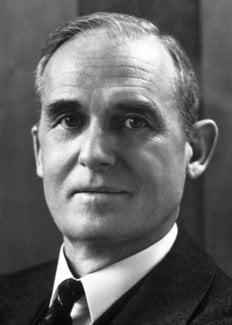William F. Giauque
Biographical

William Francis Giauque was born in Niagara Falls, Canada, of U.S. parentage, on May 12, 1895, the first of three children of William Tecumseh Sherman Giauque and Isabella Jane Duncan.
He attended public grammar schools principally in Michigan. Following the death of his father, in 1908, the family returned to Niagara Falls, Canada, where he received his secondary school education in the Niagara Falls Collegiate Institute. After graduation he sought employment in various power plants at Niagara Falls for financial reasons and because he had planned for many years to become an electrical engineer and wanted preliminary experience. He was unable to obtain this type of work. At this point chance entered decisively in the form of a newspaper advertisement of the Hooker Electro-Chemical Company in Niagara Falls, New York, which led him to accept employment in their laboratory. The well-organized operations in this chemical plant, together with problems which he saw in course of solution, captured his interest and caused him to decide to become a chemical engineer.
After two years employment he entered the College of Chemistry of the University of California, where he received the B.S. degree with highest honors in 1920, was a University Fellow for the year 1920-1921 and James M. Goewey Fellow 1921-1922. He received the Ph.D. degree in chemistry with a minor in physics in 1922.
Although his undergraduate work at the university was selected with the idea of an engineering career, he soon acquired a liking for fundamental research. The emphasis on scientific investigation by the group of faculty and students associated with Professor Gilbert N. Lewis was the major influence.
He was appointed Instructor of Chemistry in 1922 and after passing through the intermediate grades of professorship he became Professor of Chemistry in 1934.
His interest in the third law of thermodynamics as a field of research was aroused by the experimental work for his Ph.D. research under Professor G.E. Gibson. This work, which was concerned with the relative entropies of glycerine crystals and glass, had its origin in discussions of Professors Lewis and Gibson.
The principal objective of his researches has been to demonstrate through a considerable number and variety of accurate tests that the third law of thermodynamics is a basic natural law.
The researches of his students and himself have included a large number of accurate entropy determinations from low temperature measurements, particularly on condensed gases. The entropies and other thermodynamic properties of many gases have also been determined from quantum statistics and molecular energy levels available from band spectra and other sources.
Correlated investigations of the entropy of oxygen from its incompletely interpreted band spectrum and from low-temperature heat capacity measurements with Dr. H.L. Johnston, led to the discovery of oxygen isotopes 17 and 18 in the Earth’s atmosphere and the fact that chemists and physicists were unknowingly using different atomic weight scales.
Investigation of the effect of magnetic fields on the entropies of paramagnetic substances led to the invention of the adiabatic demagnetization method of producing temperatures considerably below 1° absolute. This method was first demonstrated in collaboration with Dr. D.P. MacDougall.
Professor Giauque’s scientific work has been described in some 75 papers.
He has received the Chandler Medal and the honorary degree of Sc.D. from Columbia University, an honorary LL.D. from the University of California, and the Elliott Cresson Medal from the Franklin Institute. In 1951 he received the Willard Gibbs Medal and in 1956 the Gilbert Newton Lewis Medal. He was Faculty Research Lecturer of the University of California in 1948. He is a member of the National Academy of Sciences, the American Philosophical Society, the American Chemical Society, Institut International du Froid, and is Fellow of the American Physical Society and of the American Academy of Arts and Sciences.
In 1932 he married Dr. Muriel Frances Ashley. They have two sons, William Francis Ashley G. and Robert David Ashley G.
This autobiography/biography was written at the time of the award and first published in the book series Les Prix Nobel. It was later edited and republished in Nobel Lectures. To cite this document, always state the source as shown above.
William F. Giauque died on March 28, 1982.
Nobel Prizes and laureates
Six prizes were awarded for achievements that have conferred the greatest benefit to humankind. The 14 laureates' work and discoveries range from quantum tunnelling to promoting democratic rights.
See them all presented here.
